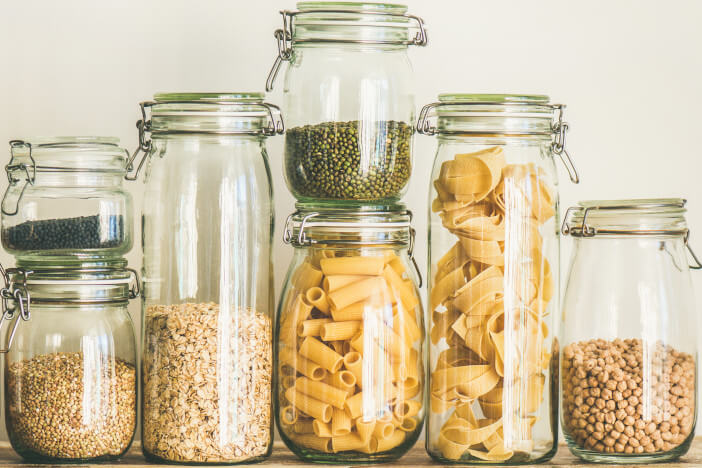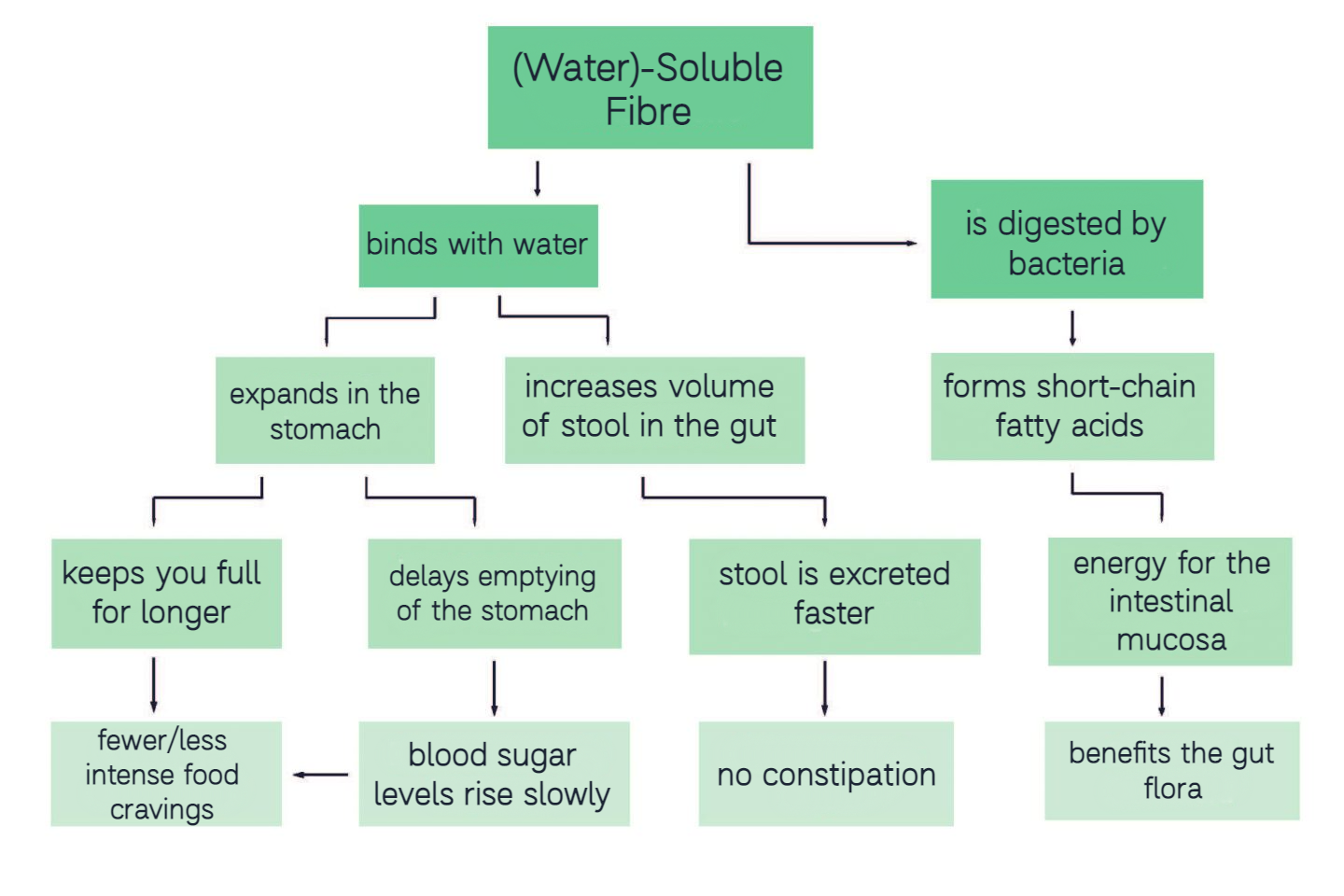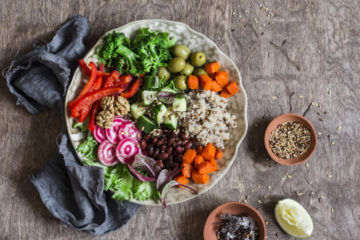Fibre – High fibre foods for a happy gut and better health

When you hear the word “fibre”, you might be reminded of tedious TV adverts that flaunt flat tummies, claiming untruthfully that fibre is the key to your dream body. What is true, however, is that fibre is indispensable for your health and can alleviate or even prevent many diseases.
In this article we aim to clear up the misconception that fibre is unimportant or unnecessary. You will learn all you need to know about fibre as well as the foods that are particularly high in this “rough stuff”!
What is fibre?

Fibres are indigestible, long-chain carbohydrates. This means that they are not digested by the body, passing all the way through with very little change. Nonetheless, fibre is extremely important for the human body and can even help you lose weight, as you will learn in the course of this article. There is both water-soluble and water-insoluble fibre. We have summarized some of the main differences for you in the table below.
| Soluble fibre | Insoluble fibre | |
|---|---|---|
| Examples |
|
|
| Found mainly in |
|
|
| Characteristics |
|
|
What does fibre do?

Fibre has many positive effects on the human body and can even aid the process of weight loss.
The characteristic properties of dietary fibre are summarized here:
- It swells by absorbing water
- It increases the viscosity and volume of the chyme (the mixture of stomach acid and partially digested food)
- It boosts and prolongs the feeling of fullness
- It feeds the gut bacteria, thus benefiting the gut flora
- It binds to bile acids, causing excess cholesterol to be excreted
Soluble Fibre
Thanks to its ability to absorb water and expand, this kind of fibre ensures that the chyme in the stomach becomes more viscous. In turn, increased stretching of the stomach causes you to feel fuller, and your blood glucose level is raised slowly, which can counteract food cravings. Furthermore, the emptying of the stomach is delayed, which means that this feeling of satiety persists longer. Water-soluble fibre increases the volume of stool in the intestine by binding with and retaining water. As a result, the bowel is forced to move more and stool is excreted faster. Additionally, this fibre is fermented in the gut to produce short-chain fatty acids. Fermentation is beneficial for the intestinal microflora.

Insoluble Fibre
Insoluble fibre also increases stool volume. Furthermore, it binds to bile acids and ammonia, which are subsequently excreted in the stool. In this way, it contributes on one hand to a reduction in cholesterol levels by preventing the digestive absorption of bile acids. On the other hand, its ability to bind ammonia increases the amount of nitrogen excreted via the intestine, reducing the burden on the liver and kidneys. Ammonia is toxic to the body and is converted into non-toxic urea by the liver. Most of this is then excreted via the kidneys and only a small amount via the stool and skin. If the liver or kidneys are damaged, the urea cannot be excreted sufficiently. As a result, urea levels can become too high and gout can develop. Those affected by gout suffer from painful inflammation of the joints.
What are the benefits of dietary fibre?

Fibre makes you feel full for longer and can even relieve constipation due to its ability to expand in the intestine. Furthermore, a diet rich in high fibre foods can reduce the risk of many diet-related diseases. For this reason, your diet should be as varied as possible to ensure a good supply of soluble and insoluble fibre. Below, you can find out which diseases can be alleviated or even prevented by a high fibre diet.
Fibre prevents obesity
The EPIC study has shown that, in general, the more fibre someone consumes, the lower their body weight is. This is due to the fact that high fibre foods, despite their low energy density, have a high satiety index. In addition, fibre promotes a slower blood sugar response due to the delayed emptying of the stomach. Consequently, less insulin is released, which ultimately means that less fat is stored. As another result of a high fibre diet, levels of satiety hormones are raised due to the further expansion of the stomach. All these factors contribute to the prevention of weight gain. It is currently being discussed whether dietary fibre can also prevent type 2 diabetes by increasing insulin sensitivity.
Effects of fibre on coronary heart disease
Both lipid metabolism disorders and high blood pressure are risk factors for coronary heart diseases, such as atherosclerosis and heart attacks. However, with a diet rich in high fibre foods, a clinical picture can be repainted in a more positive light, so to speak. Amongst other things, levels of cholesterol play a decisive role, and these can be reduced with a higher intake of soluble fibre, which absorbs bile acids. In addition, due to the short-chain fatty acids formed during fermentation, cholesterol synthesis is inhibited in the liver. Body mass and insulin sensitivity also play important roles. All of these aspects have an impact on coronary heart disease.
Coronary heart disease is one of the most common diet-related diseases.
The influence of fibre on cancer
According to the World Health Organization (WHO), an unhealthy lifestyle and poor nutrition are to blame for about a third of all cancers. Here, a high fibre diet can be of great help with its low energy density. Similarly, the short-chain fatty acids produced in the fermentation of fibre work to prevent cancer. It is currently assumed that short-chain fatty acids increase the activity of detoxification enzymes, reduce damage to the genome, and inhibit the growth of tumour cells in the intestine.
Where can you find fibre?

Fibre is the material that makes up the support structure of plants. Therefore, you will only find fibre in plant-based foods, such as fruits, vegetables, mushrooms or cereals. To increase your fibre intake, you should always opt for the wholegrain version of pasta, rice, and other cereal products. Legumes are another high fibre food. The NHS recommends a daily fibre intake of 30 g. You can easily achieve this by choosing the wholemeal version for cereal-based foods such as bread, pasta or rice and supplementing these with three servings of vegetables and two servings of fruit every day.
Would you like to get to your 30 g of fibre per day? Easy peasy – on our sample plan (below), you will be provided with a whopping 63.7 g of fibre!
| Meal | Recipe | Fibre Content (g) |
|---|---|---|
| Breakfast | Quinoa porridge | 12.2 |
| Snack | Cashew & banana milk | 5.5 |
| Lunch | One-pan poultry & potato | 5 |
| Dinner | Couscous & chickpea salad | 41 |
Don’t fancy anything here? Scroll through our recipe page (coming soon!) and find many more delicious, high fibre recipes.
How do I eat a high fibre diet?

Most adults in the UK do not reach the recommended daily amount of 30 g. For this reason, we have put together a table with which you can easily increase your fibre intake by replacing certain foods in your diet.
| Meal | Foods | Fibre content (g) | High fibre Alternatives | Fibre content (g) |
|---|---|---|---|---|
| Breakfast | 2 slices of white toast (about 50 g) | 2 | 1 thick slice of wholemeal bread (about 50 g) | 4.9 |
| 1 kiwi (about 75 g) | 2.9 | 1 kiwi (about 75 g) | 2.9 | |
| Snack | 100 g grapes | 1.6 | 1 apple (about 125 g) | 2.5 |
| Lunch | 150 g meat | 0 g | 150 g meat | 0 g |
| 200 g Brussels sprouts | 8.8 | 200 g Brussels sprouts | 8.8 | |
| 200 g white pasta | 3.8 | 200 g wholemeal pasta | 10.2 | |
| 1 small bowl of jelly (150 g) | 0 | 1 small bowl of berry compote (150 g) | 2.5 | |
| Snack | 3 shortbread biscuits | 0.5 | 3 wholemeal digestive biscuits | 2.9 |
| Dinner | 2 slices of brown bread (about 50 g) | 3 | 2 slices of wholegrain rye bread (about 100 g) | 7.7 |
| 2gherkins (about 40 g) | 0.6 | ½ bell pepper (about 100 g) | 3.6 | |
| Sofa snack | 40 g potato crisps | 1.7 | 40 g almonds | 4.5 |
| Total fibre (g) | 24.9 | 52 |
The top 10 most high fibre foods

We have put together a list of the ten most high fibre foods so that you can meet your daily needs without any fuss. A little tip: you should always drink enough to keep your intestines moving and reap the rewards of a high fibre diet. Of course, water is always the best option.
| Food | Fibre content per 100g (g) |
|---|---|
| Wheat bran | 45.1 |
| Flax seeds | 38.6 |
| Chia seeds | 34.4 |
| Shredded coconut | 24 |
| White beans, e.g. cannellini | 23.2 |
| Soy “meat” & beans | 22 |
| Prunes | 18.8 |
| Salsify (oyster plant) | 18.3 |
| Bran flakes | 18 |
| Dried apricots | 17.3 |
The negative effects of fibre

If your body is not used to high fibre foods, they can cause bloating or even diarrhoea. Therefore, you should gradually raise your intake of high fibre foods to allow your body to adapt to the increase. In addition, fibre binds with minerals such as calcium, magnesium, iron, and zinc, leaving less for the body to absorb during digestion. However, this is not much of a problem, in fact, since high fibre foods naturally contain a relatively high proportion of minerals, which compensates for any loss. That being the case, deficiency symptoms will not arise from a nutritionally balanced, mixed diet, so you have no reason to limit your fibre intake.
Conclusion

Fibre boosts our health considerably and can even alleviate diseases such as obesity, type 2 diabetes, high blood pressure and coronary heart disease. However, many find it difficult to eat the recommended amount of 30 g per day. Fibre can be very easily integrated into our everyday life with some simple food swaps. For this reason, you should always select wholegrain or wholemeal versions of foods on a high fibre diet and supplement with fruit and vegetables.
Frequently Asked Questions
What is fibre?
Fibre is tough material which serves as the support structure of plants. Fibres belong to the group of indigestible long-chain carbohydrates. The body cannot digest them and, instead, they are excreted without being altered. A distinction is made between (water-) soluble and insoluble fibre.
How much fibre should I eat?
The NHS recommends an intake of 30 g of fibre per day.
Which foods contain fibre?
Fibre is found exclusively in plant-based foods, such as cereal products, fruits, vegetables, mushrooms and legumes. The wholemeal versions of pasta, cereals or rice are much higher in fibre than their refined counterparts.
Is it possible to eat too much fibre?
If you are not yet used to fibre, too high a dosage can result in bloating and diarrhoea. Therefore, you should increase your consumption of high fibre foods steadily. Otherwise, fibre can safely be classified as unproblematic.
Sources
- NHS (last reviewed in 2022). ‘How to get more fibre into your diet’. Retrieved on 03.01.2023 from https://www.nhs.uk/live-well/eat-well/digestive-health/how-to-get-more-fibre-into-your-diet/.
- Schulze-Lohmann, Petra (2012). ‘Ballaststoffe: Grundlagen – präventives Potenzial – Empfehlungen für die Lebensmittelauswahl’. In Ernährungs Umschau (7/2012). Kiel. Retrieved on 06.08.2020 from https://www.ernaehrungs-umschau.de/fileadmin/Ernaehrungs-Umschau/pdfs/pdf_2012/07_12/EU07_2012_408_417.qxd.pdf



